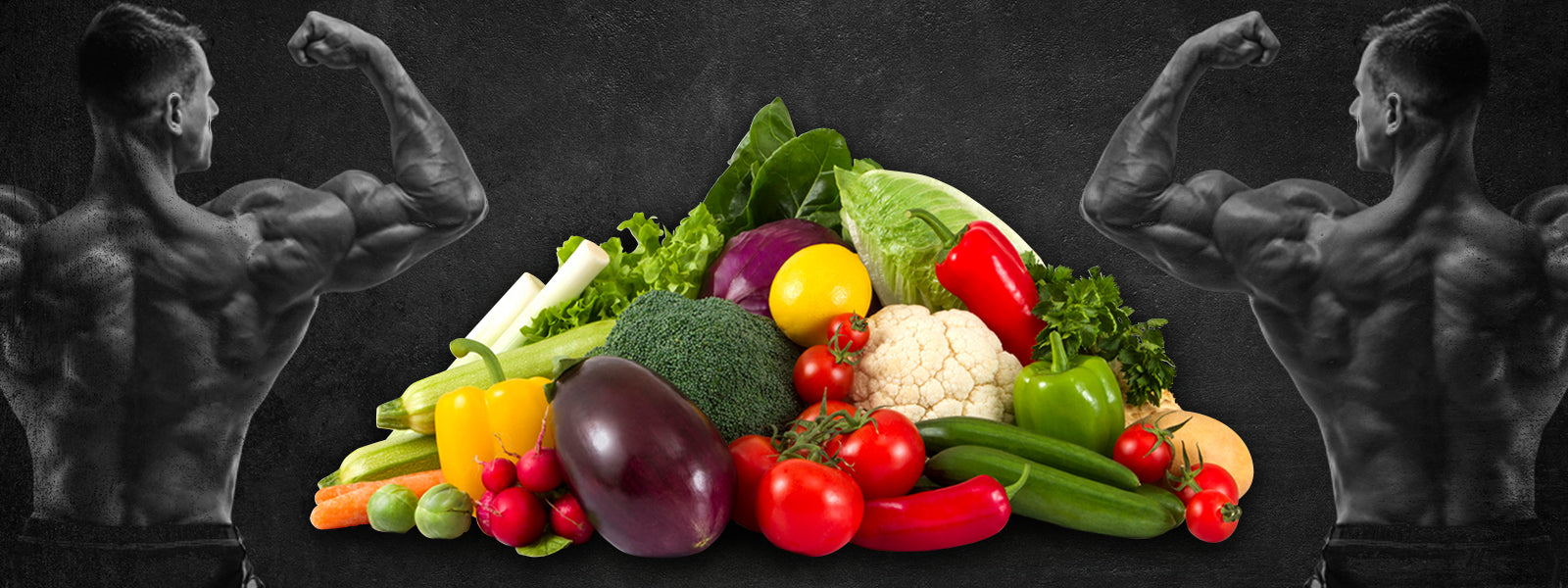Greens For Gains: 5 Surprising Ways Veggies Boost Muscle Growth

Salads aren’t just for rabbits and vegans. If your goal is to get huge, increase strength, cut body fat or just maintain where you’re at, there better be plenty of greens in your muscle building meal plan! Honestly, a meal without greens just ain’t a real meal
Why? There’s plenty of reasons, but we’ll stick to the ones that are most important to your goals - get big, lift heavy, and be awesome. Maybe even get a girlfriend
Alright, let’s chow down and start with the easiest point to digest!
THE BULKIEST BODYBUILDING FOODS: VEGETABLES!
Vegetables add bulk to your meals and contain fibre, keeping you full and stabilising blood sugar levels.(1) This helps regulate appetite so you don’t overeat or undereat - key to a peak physique! Having greens with each meal also helps bowel movements, so after you “deload” in the bathroom you can more easily eat your other meals of the day. Gotta make room for all your other foods for building muscle!
BRINGING BALANCE TO A HIGH PROTEIN DIET

Daily vegetable intake should be something you track just as carefully as your protein intake. High protein foods like meat, eggs and dairy are acidic foods, and over time, highly acidic diets can wreak havoc on your physical performance - including muscle wastage, fatigue, cardiovascular disease, weaker bones, and reduced IGF-1 hormone, which regulates growth.(2)(3)
Stay anabolic by eating more vegetables and fruits, which are alkaline foods that balance the acidity of a high-protein diet. Alkaline foods also reduce inflammation and strengthen your immune system, which means less sick days and more gym days!(4)
In case you’re wondering “how much vegetables to eat per day” just make a fist. That’s one serving - aim for 5 to 10!(5)
VEGETABLES CAN PROTECT YOUR TESTOSTERONE

The benefits of vegetables include testosterone support, which you need for building muscle and other manly functions. The best types are the cruciferous vegetables, like broccoli, cauliflower, brussel sprouts, kale, and all the other ones that make you gassy (sorry, it’s true). They contain a compound called indole-3-carbinol, which your body then converts into another compound called DIM - a popular ingredient in testosterone boosting supplements!(6)
DIM breaks down the bad types of estrogen, which in turn helps your body maintain a healthier balance of good estrogen and normal testosterone levels. Not only does this protect against cancer, it also means less water retention and body fat, and more muscle growth, strength and stamina.(7)(8)
So, if you or a gym bro suffer from “man boobs” (called gynecomastia), try swaps like a cauliflower crust pizza or blending kale into your protein smoothies - we promise you won’t turn into a hipster millennial obsessed with brunch dates, yoga pants and Live Laugh Love posters. But you will get jacked.
Speaking of getting jacked...
GREENS GIVE YOU LONG-LASTING PUMPS

Wanna know how Popeye the Sailor got such huge arms? (Okay, he only had huge forearms, but you know what we mean). It really was all that spinach! Plant foods, especially leafy greens, are rich in nitrates, which your body then turns into nitric oxide - the magic behind juicy pumps and roadmap veins!(9)
Certain vegetables, like spinach and beets, are also rich sources of betaine - a common pre-workout ingredient that increases workout volume, power output, and can also improve body composition.(10)
While a handful of leaves won’t exactly replace a dose of pump pre-workout, regular consumption still helps maintain better blood flow overall. This translates to more oxygen and nutrient delivery for speedier recovery and growth - and for you older gents, lower heart disease risk, too.(11)
HARDER MUSCLE CONTRACTIONS
Cranking out hard and heavy reps without getting cramps is another reason to eat more veggies and fruits. They’re rich in countless vitamins and minerals - including electrolytes like sodium, potassium, magnesium and calcium - that help proper nerve signalling for stronger muscular contractions. and easier relaxation. (12)
Of course, crushing a plate of broccoli and apples won’t help you hit a PR right away, but you’ll have an easier time squeezing and relaxing your muscles for harder reps and deeper rest.
HOW TO EAT MORE FRUITS & VEGGIES EASILY
So, greens have loads of muscle benefits - but here's the problem. It requires lots of prep to get in the recommended 5-10 fistfuls of fruits and vegetables every day. Washing, chopping, and cooking everything takes time and effort, and even though our easy MEAL PREP CHEAT SHEET can make this process simpler, it’s still a LOT to swallow - literally!
But we do have something that can help even more if you’re still struggling
FLEX FOOD is the meal replacement shake that actually contains 46 real food ingredients - and half of those are alkalizing greens, fruits and superfoods to help you meet your daily intake requirement!

In just 20 seconds you can get a complete muscle building shake with whey and plant proteins, complex carbs and healthy fats, added gut support, vitamins and minerals, electrolytes, and of course, plenty of greens.
Of course, you should still eat as many real whole foods as possible, but it’s not always possible. That’s why we made FLEX FOOD - the fast food with attitude! It saves time and your diet for when it’s too difficult to stay disciplined. If that sounds like something you need... TRY FLEX FOOD HERE
REFERENCES
(1) FIBRE & BLOOD SUGAR - Centers for Disease Control and Prevention. (2022, February 4). Fiber: The CARB that helps you manage diabetes. Centers for Disease Control and Prevention. Retrieved May 3, 2022, from https://www.cdc.gov/diabetes/library/features/role-of-fiber.html#:~:text=Health%20Benefits%20of%20Fiber&text=Specifically%2C%20fiber%20can%20help%3A,sugar%20in%20your%20target%20range.
(2) ACIDIC FOOD RISKS - S. Goldfarb, “Dietary factors in the pathogenesis and prophylaxis of calcium nephrolithiasis,” Kidney International, vol. 34, no. 4, pp. 544–555, 1988.
(3) ACIDIC FOOD RISKS - S. A. Bingham, “Meat or wheat for the next millennium? Plenary lecture. High-meat diets and cancer risk,” Proceedings of the Nutrition Society, vol. 58, no. 2, pp. 243–248, 1999.)
(4) ALKALIZING BENEFITS - Schwalfenberg G. K. (2012). The alkaline diet: is there evidence that an alkaline pH diet benefits health?. Journal of environmental and public health, 2012, 727630.
https://doi.org/10.1155/2012/727630
(5) SERVINGS PER DAY - Harvard School of Public Health. (2021, March 3). Vegetables and fruits. The Nutrition Source. Retrieved May 4, 2022, from https://www.hsph.harvard.edu/nutritionsource/what-should-you-eat/vegetables-and-fruits/#:~:text=A%20diet%20rich%20in%20vegetables,help%20keep%20appetite%20in%20check
(6) CRUCIFEROUS BENEFITS - Higdon, J. V., Delage, B., Williams, D. E., & Dashwood, R. H. (2007). Cruciferous vegetables and human cancer risk: epidemiologic evidence and mechanistic basis. Pharmacological research, 55(3), 224–236. https://doi.org/10.1016/j.phrs.2007.01.009
(7) CRUCIFEROUS VEGGIES & CANCER - Liu, B., Mao, Q., Cao, M., & Xie, L. (2012). Cruciferous vegetables intake and risk of prostate cancer: a meta-analysis. International journal of urology : official journal of the Japanese Urological Association, 19(2), 134–141. https://doi.org/10.1111/j.1442-2042.2011.02906.x
(8) CRUCIFEROUS VEGGIES & CANCER - Thomson, C. A., Ho, E., & Strom, M. B. (2016). Chemopreventive properties of 3,3'-diindolylmethane in breast cancer: evidence from experimental and human studies. Nutrition reviews, 74(7), 432–443. https://doi.org/10.1093/nutrit/nuw010
(9) NITRATES IN PLANTS - Hord, N. G., Tang, Y., & Bryan, N. S. (2009). Food sources of nitrates and nitrites: the physiologic context for potential health benefits. The American journal of clinical nutrition, 90(1), 1–10. https://doi.org/10.3945/ajcn.2008.27131
(10) BETAINE FOR POWER - Cholewa, J. M., Wyszczelska-Rokiel, M., Glowacki, R., Jakubowski, H., Matthews, T., Wood, R., Craig, S. A., & Paolone, V. (2013). Effects of betaine on body composition, performance, and homocysteine thiolactone. Journal of the International Society of Sports Nutrition, 10(1), 39. https://doi.org/10.1186/1550-2783-10-39
(11) BLOOD PRESSURE & BLOOD FLOW - Appel LJ, Moore TJ, Obarzanek E, Vollmer WM, Svetkey LP, Sacks FM, Bray GA, Vogt TM, Cutler JA, Windhauser MM, Lin PH. A clinical trial of the effects of dietary patterns on blood pressure. New England Journal of Medicine. 1997 Apr 17;336(16):1117-24.
(12) MINERALS FOR PERFORMANCE - Williams, M.H. Dietary Supplements and Sports Performance: Minerals. J Int Soc Sports Nutr 2, 43 (2005). https://doi.org/10.1186/1550-2783-2-1-43
DISCLAIMER - All training, fitness and physical activity information provided herein, including but not limited to exercise types, exercise frequency, training routines/programs are for educational and informative purposes only, and does not constitute as being, and should not be taken as, professional or medical advice. We are not Medical Doctors. Use of the information is at the sole risk of the reader. Consult your family doctor and/or health care professional before starting this or any fitness program to determine if it is the right fit for your unique needs. This is particularly true if you (or your family) have a history of high blood pressure or heart disease, or if you have ever experienced chest pain when exercising or have experienced chest pain in the past month when not engaged in physical activity, smoke, have high cholesterol, are obese, or have a bone or joint problem that could be made worse by a change in physical activity.
Do not start this fitness program if your physician or health care provider advises against it. It is not intended to: substitute for and/or provide informed medical advice; act as diagnosis, treatment, cure, prevention, or care for any disease and/or condition. You should not: rely solely on this information, and/or; use this information to diagnose, treat, cure, prevent and/or care for any disease and/or health problems.


